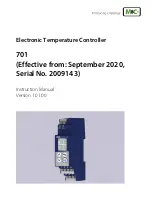
L-VIS User Manual
200
LOYTEC
Version 6.2
LOYTEC electronics GmbH
Direction
: This is the data point direction. Use input, output or value as
directions.
Unit
: For analog data points, this property contains the definition of an
engineering unit of the scalar value. A human-readable text for the engineering
unit is displayed and can be selected from a list of known units. If a correct unit
was selected, it is displayed with a green checkmark (see Section 10.1.11).
Unit for display
: If the data point has a convertible unit, an alternative unit for
display can be chosen. The data point value on the web interface is converted to
and displayed in the display unit (e.g., °F instead of °C).
Analog Datapoint Max Value
: For analog data points this property contains the
upper limit of the supported value range. Note that this does not define an alarm
limit and has no impact on the data point function in general.
Analog Datapoint Min Value
: For analog data points this property contains the
lower limit of the supported value range. Note that this does not define an alarm
limit and has no impact on the data point function in general.
Analog Datapoint Precision
: For analog data points this property defines the
number of decimals. ‘0’ specifies an integer value. Display units may use this to
format the floating point value accordingly.
Analog Datapoint Resolution
: For analog data points, this property defines the
smallest possible value increment.
Analog Point COV Increment
: This property is valid for analog input data
points. It specifies by which amount the value needs to change, before an update
is generated. If every write shall generate an update even when the value does not
change, specify 0 as the COV increment. If any value change shall generate an
update, delete the value, which results in
Any
.
Active Text
: For binary data points, this property defines a human-readable text
for the active state (true).
Inactive Text
: For binary data points, this property defines a human-readable
text for the inactive state (false).
Current State Map
: For multi-state data points this property defines the multi-
state map. It must be set to a valid multi-state map or it points to
User/UndefinedStates. Click on
to assign a state map.
State Count
: For multi-state data points this property defines the number of
discrete states.
State Text
: For multi-state data points this property defines a human-readable
state label for each state.
10.6.4 CEA-709 Properties
Apart from the common data point properties discussed in Section 10.6.3, data points of the
CEA-709 technology have additional properties. Depending on whether a NV is local or
external (remote), the properties may vary.
NV Allocation
: This property defines how a data point shall be allocated on the
device. Choices are
Static NV
,
Dynamic NV
, and
External NV
. If the allocation
type cannot be changed, this property is locked.
SNVT
: This property defines the SNVT of the NV, e.g.,
lux (79)
.
Invalid Value
: This property defines the invalid value for the NV. If set, this
specific value will be interpreted as invalid in the data point. If known by the
SNVT, the invalid value is filled in. Otherwise, the user can specify an invalid
value.
















































